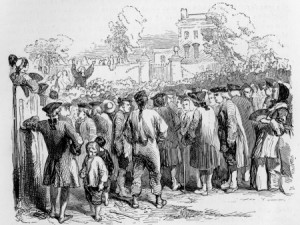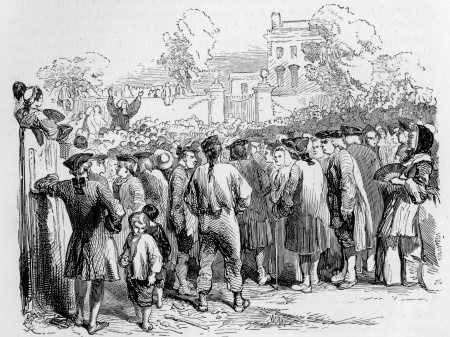
Beginning in December of 1734, the first wave of revival in Northampton Massachusetts reached its zenith around March and April of 1735. In his account of that time, A Faithful Narrative of the Surprising Work of God, Jonathan Edwards observed there were two effects. First there was a change in former sinful practices. People forsook their former vices. They stopped their old quarrels and backbitings. “The tavern was soon left empty.”
The other effect was that people earnestly applied themselves to the “means of salvation.” That is, they actively prayed, read Scripture, meditated, sought out private conference (counseling) with their minister and actively participated in worship. “It was no longer the tavern, but the minister’s house that was thronged far more than ever the tavern had wont to be.” Some who had been exceedingly entangled with one temptation or another “were soon helped over former stumbling blocks.”
According to Ian Murray, Edwards’ Faithful Narrative was possibly the most important book to precede “the great evangelical awakening on both sides of the Atlantic.” It went through three editions and twenty printings between 1737 and 1739. It also caught the attention of men like John Wesley, who wrote in his journal of “the truly surprising narrative of conversions lately wrought in and about the town of Northampton, in New England.” But the fire of revival burned down to the point that one minister wrote in the spring of 1740, “Religion lay as it were a-dying and ready to expire its last visible breath of life in this part of the visible church.”
But then George Whitefield reached Philadelphia at the beginning of November in 1739. On November 16th, he wrote to Edwards at Northampton. In a letter from Edwards to Whitefield dated February 12, 1740, he invited Whitefield to stop at Northampton. Within his letter, Edwards said: “I have a great desire, if it be the will of God, that such blessing as attends your person and labours may descend on this town.” Whitefield was not able to come to Northampton for another eight months. But as Ian Murray commented in his biography of Jonathan Edwards, by then “a general revival in the country had already begun.”
On October 17, 1740, George Whitefield wrote in his journal that he crossed the ferry to Northampton Massachusetts, where 300 souls had been “savingly brought home to the dear Lord Jesus” 5 or 6 years ago. That evening in the church where Jonathan Edwards was the pastor, he reminded the congregation of their former experiences; how zealous and lively they were at that time: “Both minister and people wept much.” Whitefield preached again on Saturday and twice on Sunday. Edwards was again noted by Whitefield to be weeping at the Sunday morning sermon and the people in attendance were equally, if not more, affected. Of the Sunday afternoon sermon, Whitefield said the Lord kept the good wine for last. He had not seen four such gracious meetings together since his arrival. Whitefield wrote in his Journals:
My soul was much knit to these dear people of God, and tho’ I had not time to converse with them about their experiences, yet one might see, that for the most part, they were a gracious tender people; and tho’ their former fire might be greatly abated, yet it immediately appeared, when stirred up.
Edwards wrote in a letter that a “visible alteration” had begun in Northampton in the spring before Whitefield’s visit. “There was more serious and religious conversation, especially among the young people.” Individuals were frequently consulting with their minister about salvation. And these changes continued until the time of Whitefield’s visit. Edwards described the effect Whitefield had as follows:
The congregation was extraordinarily melted by every sermon; almost the whole assembly being in tears for a great part of sermon time. Mr. Whitefield’s sermons were suitable to the circumstances of the town; containing a just reproof of our backslidings, and in a most moving and affecting manner, making use of our great professions, and great mercies, as arguments with us to return to God, from whom we had departed.
Edwards said that immediately afterwards people seemed more engaged in religion. They met together and talked with one another about religious things. They embraced every opportunity to hear the word preached. This continued throughout the following year. Ian Murray said: “No one could well keep track of the number of places which were also witnessing the revival.” The Great Awakening had begun.
In May of 1741, two people were “so greatly affected with a sense of the greatness and glory of divine things,” that it had a visible effect on their bodies. These scenes became common and reached their peak, according to Edwards, in August and September.
The months of August and September were the most remarkable of any this year, for apprearances of the conviction and conversion of sinners, and great revivings, quickenings, and comforts of professors, and for extraordinary external effects of these things. It was a very frequent thing, to see a house full of outcries, faintings, convulsions, and such like, both with distress, and also with admiration and joy.
Edwards and other preachers of the Awakening were constantly in demand to travel and preach in other towns. One of the places to which Edwards received and accepted an invitation was to the town of Enfield Connecticut, about thirty miles south of Northampton. He had been invited to preach there by the Enfield minister because he saw the town as “particularly stubborn to the message of the gospel.”
He repeated a sermon he had previously given to his own congregation, using Deuteronomy 32:35 as his text, on the subject of “Sinners in the Hands of an Angry God.” According to John Currid in his Foreword to the P&R Publishing edition of Edwards’ famous sermon preached at Enfield, the response of the congregation was amazing. Before Edwards had finished the sermon, people were moaning, groaning and crying out, wanting to know what they needed to do to be saved. An eyewitness said that Edwards was obliged to speak to the people and ask them to be quiet so that he might be heard. His preaching style was not flamboyant, like Whitefield. He “set his eyes on the bellrope at the rear, and spoke the words in a level tone, and with no high pomp of rhetoric or oratory.”
Incredibly, Edwards never mentioned this sermon in any of his other writings. Currid speculated this was because what happened in Enfield was a common occurrence in the revival of the summer of 1741.
Some of Edwards’ published works on revival, namely A Faithful Narrative of the Surprising Work of God, and The Distinguishing Marks of a Work of the Spirit of God were published and extensively circulated in England and Scotland at the time. Among those who were greatly encouraged to seek a time of revival from reading these works of Edwards was William McCulloch, the minister at Cambuslang. Providentially, George Whitefield had a crucial role in igniting the revival fires at Cambuslang as well as Northampton. See more on this in “Swift as Lightning.”
It’s been over 250 years since the Great Awakening and the times of revival at Northampton and Cambuslang. In both places, the physical effects were seen as incidental to the work of the Holy Spirit in the revival by many of its leaders. In Distinguishing Marks, Edwards said he did not expect a future restoration of the miraculous gifts described in First Corinthians 13, nor did he desire it. It appeared to him it would add nothing to that time and would even diminish it.
I would therefore entreat the people of God to be very cautious how they give heed to such things. I have seen them fail in very many instances, and know by experience that impressions being made with great power, and upon the minds of true, yea eminent, saints—even in the midst of extraordinary exercises of grace, and sweet communion with God, and attended with texts of Scripture strongly impressed upon the mind—are no sure signs of their being revelations from heaven.
The sure signs of revival are not the “extraordinary external effects,” the moanings, the fallings, the crying out. There is a visible alteration—you renounce your former vices and sins and you earnestly apply yourself to the means of salvation. These signs of revival proceed from a new heart; a heart of flesh to replace your heart of stone. And God will put his Spirit within you and cause you to walk in his statutes and obey His rules (Ezekiel 36:26-27).





